Imagination Announces B-Series GPU IP: Scaling up with Multi-GPU
by Andrei Frumusanu on October 13, 2020 4:00 AM EST- Posted in
- GPUs
- Imagination Technologies
- SoCs
- IP
Introducing BXS Series: Functional Safety for Autonomy
Besides targeting higher performance design targets, an area where Imagination is putting a higher level of focus on is the automotive and industrial markets. To cover these use-cases, Imagination is today also launching the new “BXS” series of GPU IP – where the S stands for safety.
The new GPU IP line-up mirrors the standard BXT, BXM and BXE configurations, but adds support for ISO 26262 / ASIL-B functional safety features.
Imagination is introducing a new feature called “Tile Region Protection” in which a configurable region of render tiles on the render frame can be marked as safety critical, and for which the GPU can check for correct execution and rendering, allowing it to be ISO 26262 certified.
TRP is implemented from the smallest BXE-equivalent BXS GPU (Frankly Imagination could have done better here than calling the whole safety line-up BXS), allowing for work repletion to achieve fault detection. Furthermore, Imagination allows for end-to-end data integrity protection via CRC checking of all data going in and out of the GPU, further helping the IP achieve safety requirements.
TRP require a single GPU to repeat work, which in turn would mean reduced performance in a system. A more performance-oriented way of scaling things would be a multi-GPU implementation.
A multi-GPU configuration in an automotive design would also server the purpose of partitioning the GPUs for multiple independent workloads; whilst in a consumer implementation you would expect the GPUs to mostly act and appear as a single large unit to a host, automotive use-cases could also have the multiple GPUs act completely independently from each other. It’s also possible to mix- and match GPUs, for example a 4-core implementation could have 3 partitions, with two GPUs working together to pool up resources for a more demanding task such as the infotainment system, while two other GPUs would be handling other independent workloads.
Imagination naturally also continues to support hardware virtualisation within one single GPU with up to 8 “hyperlanes” (guests). So, you could split up a 2-core design into 3 partitions, such as depicted above.
Beyond the addition of safety critical features on the BXS series, the automotive IP also features some specific enhancements in the microarchitecture that allows for better performance scaling for workloads that are more unique to the automotive space. One such aspect is geometry, where automotive vendors have the tendency to use absurd amounts of triangles. Imagination says they’ve tweaked their designs to cover these more demanding use-cases, and together with some MSAA specific optimisations they can reach up to a 60% greater performance for these automotive edge-cases, compared to the regular non-automotive IP.


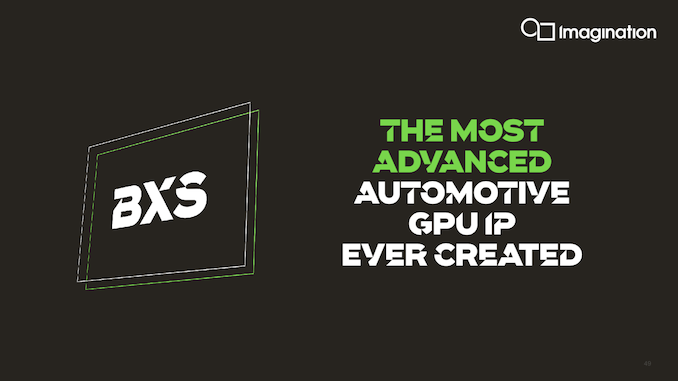
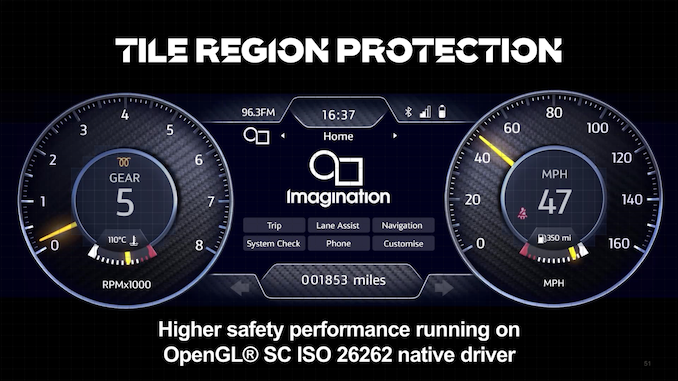
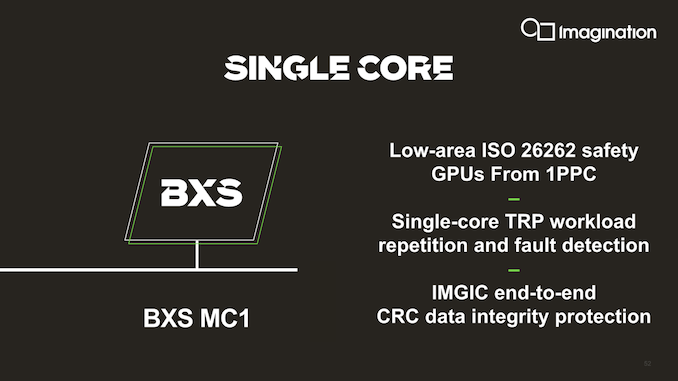
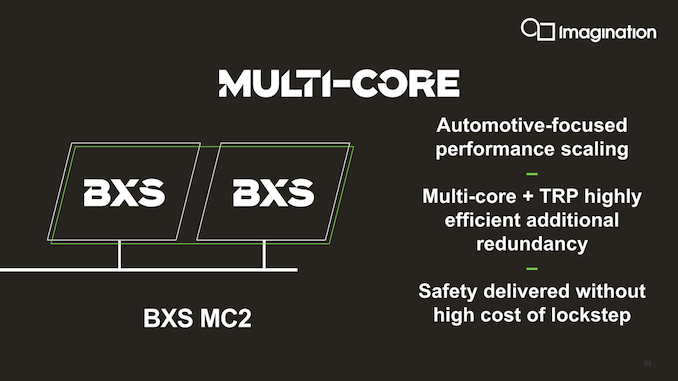
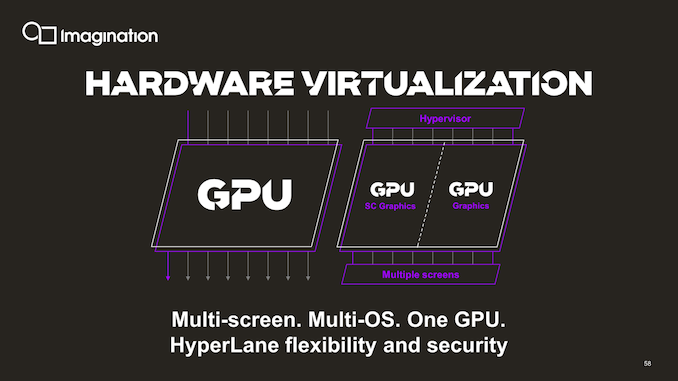









74 Comments
View All Comments
Obi-Wan_ - Tuesday, October 13, 2020 - link
Is this something that could transition to the desktop consumer space at some point? Either the Imagination IP or just the pull/push change.yeeeeman - Tuesday, October 13, 2020 - link
I am also wondering about this.To me it seems a bit strange why they don't take this step given that their revenues from mobile are getting slimmer and slimmer.
Arsenica - Tuesday, October 13, 2020 - link
Imagination Technologies may be British but it's owned via shell-companies by the Chinese government. Finding viable revenue streams no longer matters to them.This product may eventually transition to China-only PCs, but in the meantime (as it's implied in Innosilicon PR) it's targeted for Chinese data centers.
Threska - Wednesday, October 14, 2020 - link
Getting the Apple contract is indeed a big deal.https://technode.com/2020/04/15/imagination-techno...
Otritus - Tuesday, October 13, 2020 - link
I would imagine the consideration is money and competition. Imagination has no mindshare in the consumer market, and lacks many gaming-centric features (and good drivers) that would essentially eliminate adoption. The MGPU seems like it will be the future of gpu computing, but right now putting multiple slabs of silicon together and efficiently connecting them is expensive and power hungry which is undesirable.myownfriend - Tuesday, October 13, 2020 - link
What gaming centric features are they missing and how do you know they have shitty drivers?Otritus - Wednesday, October 14, 2020 - link
To my knowledge, their gpus do not currently support APIs such as DX12, lack a freesync/gsync competitor, reduced input latency, game streaming, etc. In terms of drivers they have no public drivers for windows or linux, meaning their drivers are unoptimized for desktop usage.myownfriend - Wednesday, October 14, 2020 - link
You're conflating a few things. Adaptive sync or Freesync is a feature of the display controller not the GPU. As has been stated, Apple has used Imagination's GPU IP for years and that includes the iPad Pro which supports dynamic refresh rates.Game streaming is a way that software uses a GPUs hardware decoder. All it would require is something like Moonlight supporting it.
I don't know what reduced input latency is supposed to refer to here since that has to do with a bunch of things that aren't the GPU.
I can't say for certain if they support DirectX 12 but they have supported OpenGL, Vulkan, and DirectX 11 for a long time. Considering many DirectX 11 GPU were able to support DX12 via a driver update, that's very likely something that they could do the same. If they can't then they would still be an option for Linux users.
Lastly, Imagination makes GPU IP meaning they don't manufacture actual chips. They license out designs so you're not gonna go to Imagination's website and see download list for their drivers. You can, however, look at Imagination's YouTube channel and see their cards running on Linux and Windows desktops so those drivers exist.
Kangal - Friday, October 16, 2020 - link
He's "Technically wrong" but from the consumer's viewpoint he's entirely right. There's a lot of work ImaginationTechnologies have to do to get their PowerVR GPUs to the desktop space then catch-up and compete against the likes of Nvidia's Ampere GPUs (industry standard).Normally, I would say that's easy. PowerVR has actually been an innovator and sometimes a leader in the GPU field, albeit from the shadows. But now? I doubt it.
Rant:
Firstly with 2020 being what it is. More importantly, the company is shifting massively with their CEO ousted, board members changing, and their Senior Engineers leaving after the aggressive Chinese buyout. The British seem to be angry about the whole thing, but it was so predictable, they're too naive. I'm not sure if what's left of PowerVR will have the leadership and talent anymore to get the job done. Perhaps these A-Series and B-Series are the end of their hard work, and in a few years time they will hit the wall (kinda like Intel did after SkyLake). Their short-handed won't affect Apple much, since they actually have their own GPU designers and don't rely on PowerVR much anymore. So I can see these valuable staff being poached by Apple-SoC, ARM-Mali or even Qualcomm-Adreno teams. Hopefully they don't add to the monopoly with Nvidia/AMD teams.
myownfriend - Friday, October 16, 2020 - link
I can agree with all that. It would be very difficult for them to break into a field that's been team red and team green for some people's entire lives. If they do fall apart, I'd say Nvidia would be the worst case scenario as their recent purchase of ARM is allowing them to wield a gross amount of power.